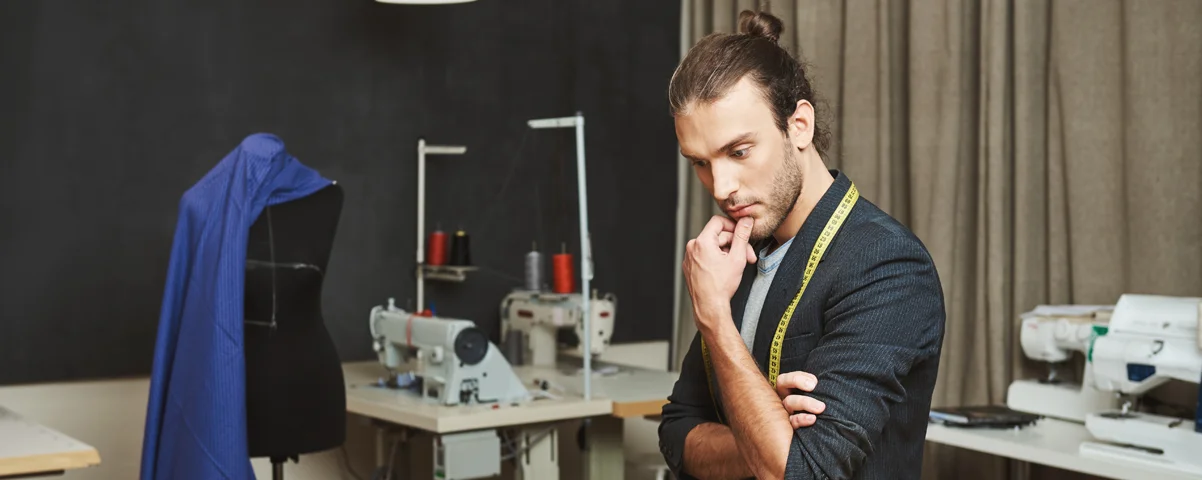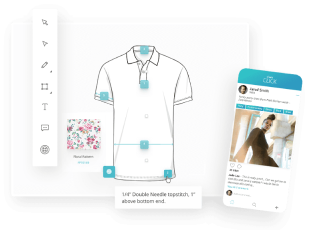5 common problems faced by the fashion industry (with solutions!)
Introduction
From struggling designers to fast fashion controversies, the problems in the fashion industry are enough to make even the most experienced of fashion veterans want to throw in the towel.
If you look at the last few years, the fashion and apparel industry made a lot of headlines for all the wrong reasons in the last few years – from sweatshops in developing countries and greenwashing sustainability claims to zero-hour contracts and burning excess inventory. Fashion businesses have faced a lot of criticism recently, but this feedback can also work as a catalyst for brands to improve their practices and stay competitive in the face of challenging industry problems.
Every business has growing pains but the increasingly fragmented and global nature of the apparel supply chain makes it all the more susceptible to pitfalls in some key areas. Let’s look at the 5 most common problems that fashion designers and apparel manufacturers face in this ultra-competitive industry along with solutions on how to deal with them.
The negative environmental and social impact of fashion
The fashion industry is second only to the oil industry in terms of its pollution contributions. And when you look at the whole apparel supply chain—from raw materials extraction to manufacturing to distribution to waste disposal—the industry accounts for 10% of global carbon emissions.
Fashion is also one of the worst offenders when it comes to human rights abuses and the exploitation of workers, especially women and children. According to the International Labor Organization, there are ~40 million garment workers worldwide, and 80% of them are women between the ages of 18 and 35. Many of them make less than minimum wage and work insanely long hours. In some places, female garment workers don’t even have access clean sanitation and hygiene facilities.
Further, the rising popularity of fast fashion has made it easier for consumers to buy clothing and accessories that are trendy, but also cheap. But while the clothes themselves might be inexpensive, the environmental and social cost of fast fashion is anything but.
SOLUTION? A little good news amid all the gloom. Technology is paving the way to a more sustainable future for fashion! Here’s few ways to get started:
- Ensure all the factories you work with have strict policies around worker hygiene and safety.
- Use 3D design solutions to test samples for fit, design and quality before manufacturing physical pieces to minimize waste.
- Use less resource-intensive sustainable materials that are not as harmful for the environment.
- Make use of analytics and production intelligence to forecast demand and avoid overproduction.
- Increase transparency in your supply chain by using production tracking software such as PLM and ERP to establish accountability.
- Encourage customers to resell or rent clothing instead of buying and discarding after one or two uses.
- Collect data about your supply chain to identify where there’s room for improvement and efficiency.
Fortunately, there are a number of innovative new technologies that can help solve some of these issues around transparency and factory safety while also reducing the environmental impact of fashion manufacturing.
The rise of copycats and product counterfeiting
Product counterfeiting is one of the biggest challenges facing fashion brands today who want to grow and expand their business in international markets. The counterfeit industry was estimated to be worth nearly $450 billion globally in 2019, with annual sales losses from fashion industry counterfeits amounting to $28.3 billion in 2020.
Big fashion brands have a big challenge. It’s hard to sell original high-value products when everyone wants cheap knock-offs! According to a 2022 piece by The Cut, counterfeit luxury bags have become more popular than the real ones amongst a section of New York’s elite. Meanwhile, smaller brands (especially those selling online) are at risk because they may not have the resources to stop counterfeits before they hit the grey market. And once a fake product has gone into circulation, it can be very difficult for people to tell whether it’s real or not.
Illicit counterfeiters threaten the economy, and often have customers unknowingly buying fake products that may be unsafe.
SOLUTION? Fighting counterfeiters is a difficult and uphill battle but that doesn’t mean you can’t do it. Here’s a few ways to solve this issue:
- Use NFT-based product passports to create unique digital tokens linked to a specific product. These tokens can be used to authenticate the product, making it difficult for counterfeiters to replicate or sell fake versions.
- Implement holographic labels and watermarks. These labels on product packaging and tags can make it difficult for counterfeiters to replicate the look of authentic products.
- Trademark important words or design elements, which makes it easier to pursue legal action against those who try to copy you. You can further protect your brand by working with trusted manufacturers who won’t share your design with others or fudge on materials requirements and specs.
- Encourage your consumers to buy authentic items—ideally directly from you! And by “encourage,” I mean through education, incentives, and other tactics designed to get customers excited about buying your products directly.
- Use software programs that can help you detect when someone is using your images or content without permission on the Internet. Teport the offenders as soon as you spot them.
Ultimately, don’t wait until someone has ripped off your product before you protect it. Register your designs, trademarks, and patents as soon as they’re ready—so that when they go on sale, they’re protected.
The inefficiencies of distributed and global supply chains
As mentioned above, the fashion supply chain involves a highly fragmented network of manufacturers, suppliers, retailers, and consumers. First, a fashion business has to find the right fabrics and materials for the specific styles they want to create; then they must identify a manufacturer who can turn those fabrics into garments at a competitive cost. Once manufactured, these garments have to be distributed across the globe for sale in different markets. And let’s not forget returns! This product lifecycle can include numerous subcontractors, each with their own specialty, who are typically spread across the globe.
The apparel production process involves a lot of capital up front—not only does the brand have to invest funds into making its product line, but they must also stock inventory without knowing how well those items will sell. The lack of visibility into this complex network creates a lot of inefficiencies, and ultimately results in products being delivered to the market late leading to product failure.
SOLUTION? The answer lies in the technology used to manage these supply chains. Most successful companies use software like PLM and ERP which allows them to streamline processes, automate manual functions and reduce errors. This allows them to cut costs while increasing productivity. These tools have grown in sophistication in recent years and offer businesses a wide range of features designed to help them collaborate with their partners from beginning to end. Here are some of their key features:
- Using a knowledge management platform like WFX PLM can help you get real time visibility into the entire product lifecycle, from design through production, allowing for better forecasting and more informed decision–making.
- With all information organized in one place, ERP and PLM systems enable better collaboration between departments and teams, allowing for the sharing of data and ideas in a more efficient manner.
- These systems can also automate many of the tedious and repetitive processes, thus freeing up time and resources to focus on more important tasks.
- They also allow you to track important information like delivery dates, order quantities, shipping costs and more to ensure that everything stays on schedule and nothing slips through the cracks.
As it stands, most companies are stuck in the past, relying on outdated methods of supply chain and distribution that waste time and money. But these methods can be solved with the right technology tools.
The pressure to adapt to fast-changing customer demands
In the fashion industry, diversity and inclusivity are crucial. When consumers can see themselves and their values reflected in a fashion brand, they’re more likely to identify with that brand and feel like it’s an extension of their own self-expression.
The rise of fast fashion, D2C brands and accessible e-commerce platforms have empowered consumers to demand more from their clothing: they want to be able to choose the exact color and fit of the pieces they buy.
Consumer centricity and personalization is mandatory for today’s fashion brands. The fashion industry is waking up to this reality, but many brands are still scratching their heads about how exactly to customize their business models so that they can meet their customers’ demands for diversity and inclusion—and boost their bottom line in the process.
SOLUTION? The answer lies in customization. Here are a few approaches you can try:
- Mass Customization: This approach begins with a range of options that consumers can choose from, which allows for some level of personalization. Like giving them options to choose for color or certain design features.
- Totally Personalized: This approach allows for complete customization, also know as bespoke tailoring, where consumers can control every aspect of the product.
- Co-creation: This means allowing consumers to participate in the design process and co-create with you. Take the example of Nike ID, where customers get to put their own creative flair into product designs, with do-it-yourself videos teaching people how to hack and customize their own fashion items.
- Virtual fitting solutions: Getting the sizing right is an underrated personalization feature. You can reduce returns and let customers find their best fit with 3D virtual fitting rooms and try-on technologies.
Many upstart fashion companies are able to predict and produce high demand products faster than ever by using AI/ML to manage data about trends and consumer preferences. Don’t get left behind!
The dwindling business benefits of runway shows
There was a time when fashion weeks, trade shows, and runway shows were the pinnacle of prestige and business in the fashion industry. Brands often truly made their names by presenting at these events, catching the eye of a key magazine editor or buyer who would propel their brand to the next level.
But nowadays, fashion weeks and trade shows might be past their prime. Especially as consumers shift more of their shopping behaviors online and social media takes over as the primary source of brand and product discovery, fashion shows are going down in terms of return on investment.
A show at fashion weeks, from New York to Paris, can cost anywhere from $50,000 to $250,000 per season. To top that, organizing a runway or trade show is incredibly time consuming. And when all of this investment doesn’t get you the assured business returns that these events are famous for, you know it’s time for a rethink!
SOLUTION? The answer is simple: it’s time to take your business online. There are plenty of ways for brands, designers and suppliers to find business or attention without these trade events.
- Go direct-to-consumer: there’s never been a better time to be own your sales channel and sell directly to your consumers via ecommerce or social media shops. Brands can create engaging content and use influencer marketing tactics to reach their audience.
- Pop-Up Shops: Pop-up shops offer brands a great way to create buzz around their products and services. These temporary stores provide an opportunity to reach out to customers in a physical space and market their products on the spot.
- Explore the Metaverse: The Metaverse is the hottest new playground for people on the Internet. Let your shoppers immerse themselves in your brand’s universe by creating virtual spaces on the Metaverse.
- Build a virtual showroom: While the Metaverse helps brands connect with end customers, a digital or virtual showroom is a platform for fashion businesses (like brands or suppliers) to sell and engage with each other.
The number of fashion shows and trade shows has dropped significantly in the last decade, but the number of fashion brands has increased at nearly the same rate. This means that while they’re still an integral part of the industry’s identity, fashion shows have much less impact on business than they once did.
Summary
There you have it. The fashion industry has a lot of problems facing it—problems that are largely of its own making. The key to success in this industry is to not shy away from these problems, but to tackle them head-on. Brands that focus on solving the issues faced by their customers are the ones that will come out on top. So, don’t be afraid to take a stand and make a difference.
Let’s not forget, the fashion industry is not just about creating clothing, it’s about creating an experience. It’s about making people feel good and confident in what they’re wearing. It’s about pushing boundaries and breaking the mold.
We hope this post has helped you understand how to successfully navigate the murky waters of fashion.
If you’re interested in staying updated on all these issues, or want some help implementing solutions for your business, feel free to sign up for a free consultation with one of our experts!







